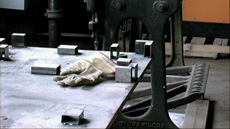 Action Toolkit (pdf) Action Toolkit (pdf) 
UNNATURAL CAUSES Public policy change is critical to achieving health equity. But how can organizations use the series to educate, organize and advocate for changes that will make a difference?aaa
The UNNATURAL CAUSES toolkit provides facilitation tips, background, sample agendas, and guidelines for planning an effective screening – one that not only deepens understanding of issues but serves as a step towards further involvement.
|
 |
 Advocating for Better Policies (pdf) Advocating for Better Policies (pdf) 
A straight-forward guide to community-based policy advocacy. Includes information on identifying the best policy strategies for your community, building coalitions, communicating with public officials, and policy options beyond legislation. Also includes inspiring examples of successful community-based policy reforms. |
 |
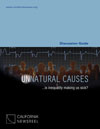 Discussion Guide (pdf) Discussion Guide (pdf) 
UNNATURAL CAUSES, 2008 This guide includes a wide range of questions and activities to engage many types of audiences in dialogue—from community members to elected officials. General prompts address the series' overall themes and key concepts, with ideas for sparking discussion before and after viewing, deepening comprehension, and turning the viewers' focus to opportunities for action in their community. Episode-specific prompts introduce the key themes presented in each episode, check for and deepened comprehension, and spark discussion around presented issues and how they may apply to their community. The guide also suggests activities to delve more deeply into key concepts, highlights features on the series' companion website, and lists additional sources for further information. |
 |
 DVD Chapter Guide DVD Chapter Guide 
UNNATURAL CAUSES, California Newsreel, 2008 Brief descriptions of the chapters on the Unnatural Causes DVD. |
 |
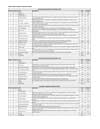 DVD Chapter Time Chart (pdf) DVD Chapter Time Chart (pdf) 
UNNATURAL CAUSES 2008 Chapter start time, end time, and length for all the episodes, along with the corresponding DVD chapter numbers. |
 |
 Health Equity Speakers List (pdf) Health Equity Speakers List (pdf) 
UNNATURAL CAUSES 2008 The series benefited from the contributions of some of the country’s leading health equity researchers, practitioners and advocates. We have pulled together a list of contributors who would be great resources for bringing additional expertise to your screening, panel, or other event. |
 |
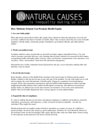 How Medical Schools Can Promote Health Equity (pdf) How Medical Schools Can Promote Health Equity (pdf) 
UNNATURAL CAUSES, 2009 This two-sided handout presents some ideas for medicals schools to use their unique position to promote health equity. |
 |
 Local Health Department National Coalition for Health Equity Local Health Department National Coalition for Health Equity 
ONLINE COMMUNITY hosted by the National Association of County and City Health Officials A learning community for local and state health departments and their staff to connect, share strategies, and develop regional alliances, hosted by NACCHO.
|
 |
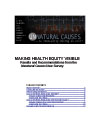 Making Health Equity Visible: Results and Recommendations from the Unnatural Causes User Survey Making Health Equity Visible: Results and Recommendations from the Unnatural Causes User Survey 
UNNATURAL CAUSES, 2009 In December 2008, California Newsreel conducted a web-based survey to better ascertain just how UNNATURAL CAUSES was being used as a tool to educate, organize, and advocate for health equity. Based on the survey findings, feedback from outreach partners, and the observations of our team, we compiled recommendations for using Unnatural Causes more effectively in the development and mobilization of a stronger movement for health equity.
You can also download the PDF of the raw charts for each question.
|
 |
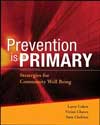 More Than a Message: Framing Public Health Advocacy to Change Corporate Practices (pdf) More Than a Message: Framing Public Health Advocacy to Change Corporate Practices (pdf) 
ARTICLE by Lori Dorfman, Lawrence Wallack, Katie Woodruff, Ch6 in Prevention Is Primary Public health advocates will be more effective when they learn how to frame their issues in the context of core values. Industry and corporate representatives tend to work within the frame of market values and personal responsibility; advocates may frame their communications based on fairness and social responsibility. The format and brevity of most news stories contributes to an individual-based, non-contextualized understanding of issues, thus advocates should work to present their issues in a clear, concise, "what's wrong? why does it matter? what should be done?" frame. |
 |
 Planning for Media Advocacy (pdf) Planning for Media Advocacy (pdf) 
A straight-forward guide to developing a media strategy and undertaking good media outreach for your group, issue, or campaign. Includes tips on framing your issue, telling compelling stories, and getting coverage. |
 |
 Policy Guide (pdf) Policy Guide (pdf) 
UNNATURAL CAUSES This guide contains a menu of policy ideas that can improve health equity. Generally, such policies aim to: tackle inequality and improving living standards, protect those at the bottom of the pyramid, and reform decision-making processes. |
 |
 Promoting Health Equity: A Resource to Help Communities Address Social Determinants of Health (pdf) Promoting Health Equity: A Resource to Help Communities Address Social Determinants of Health (pdf) 
WORKBOOK - Centers for Disease Control and Prevention, 2008 This workbook is for community-based organizations seeking to affect the social determinants of health through community-based participatory approaches and nontraditional partnerships. Along with an introduction to the concepts of health equity, the workbook presents case studies of communities working at both small and large scales. The authors then provide guidelines for developing your own initiative, from creating partnerships to identifying your approach to assessing and maintaining your progress. |
 |
 UNNATURAL CAUSES Episode Descriptions - All Shows UNNATURAL CAUSES Episode Descriptions - All Shows 
One pdf with all the summaries of each of the seven shows in the series. |
 |
 UNNATURAL CAUSES Flyer (pdf) UNNATURAL CAUSES Flyer (pdf) 
UNNATURAL CAUSES 2009 This two-sided flyer introduces the series along with the tools and resources available on the companion Web site. Be sure to download both sides!
Flyer Front (pdf)
Flyer Back (pdf) |
 |
 UNNATURAL CAUSES Frequently Asked Questions UNNATURAL CAUSES Frequently Asked Questions 
The answers to common questions about broadcast, DVD distribution, and the Public Engagement Campaign. |
 |
| |




